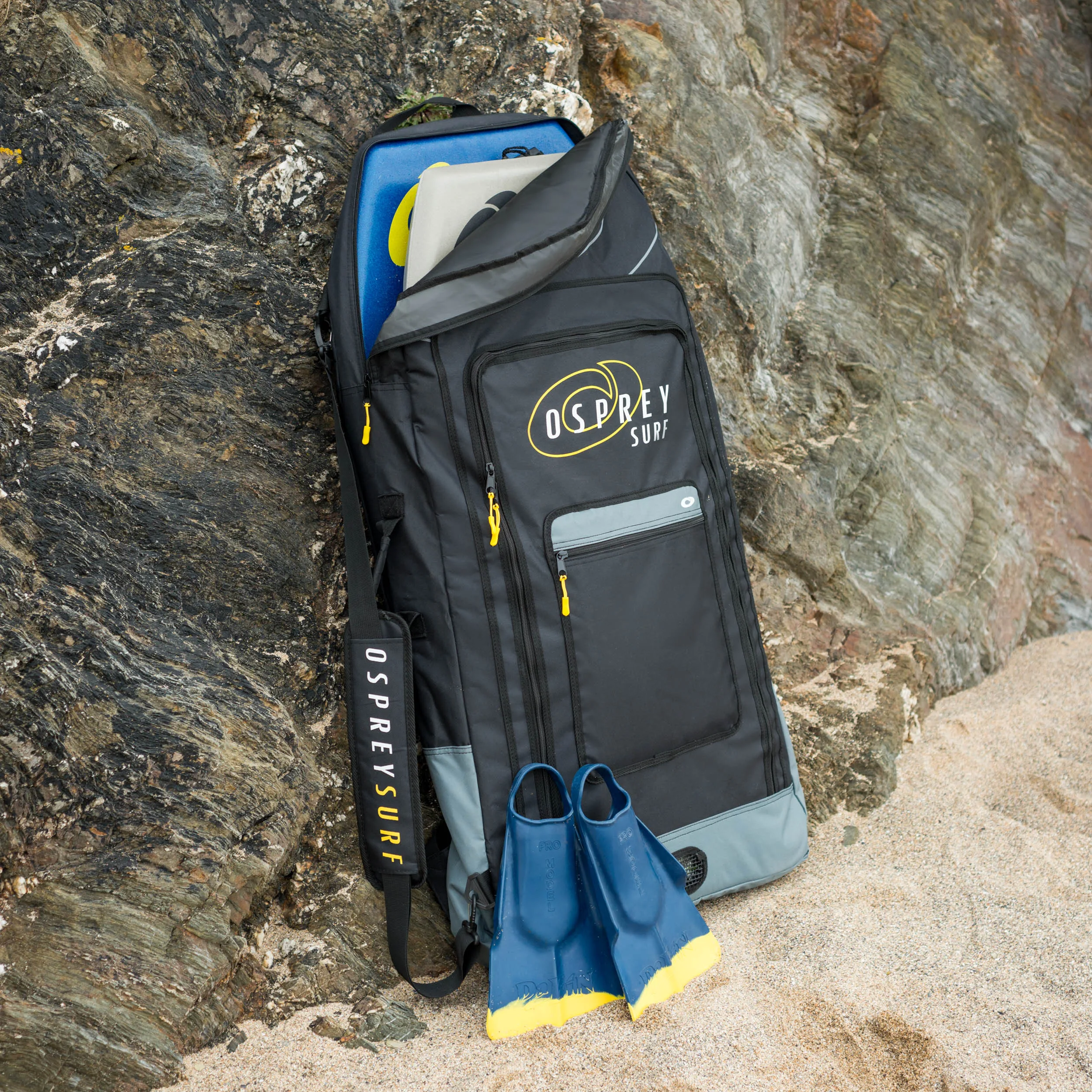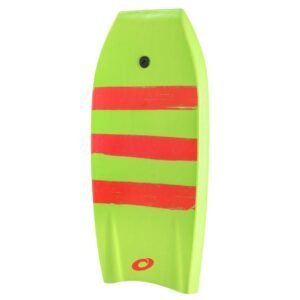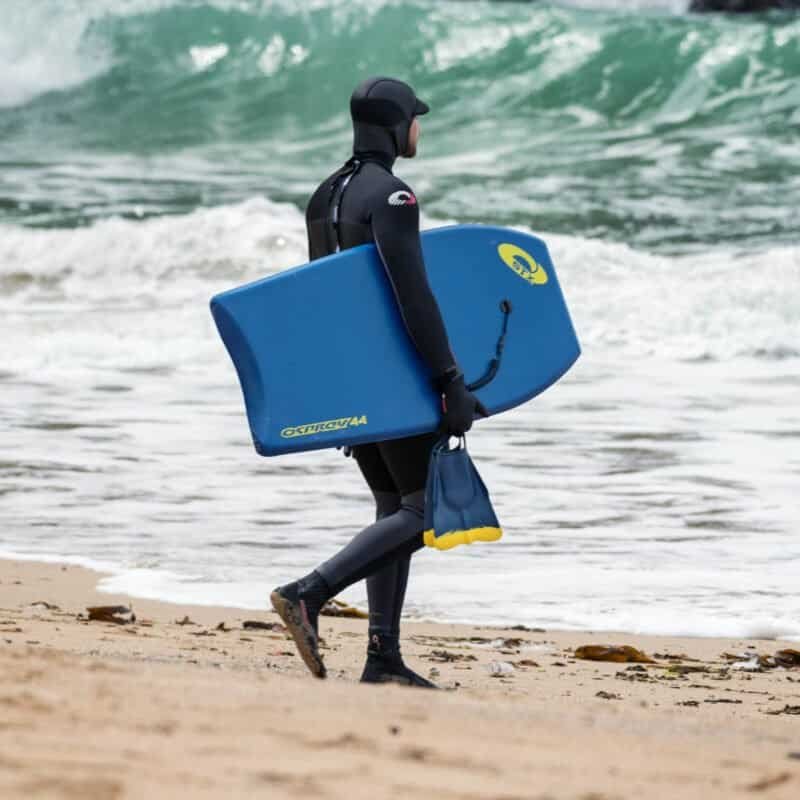The basics of bodyboards
A bodyboard is designed with specific features to perform optimally in the water. The three main components of a bodyboard are:
Core (core): This determines the board's stiffness, flexibility and durability.
Slick (bottom): Provides speed, smooth gliding and stability in the water.
Deck (top): Provides grip and comfort, keeping you firmly on the board.
Core: the core of the bodyboard
The core of a bodyboard determines how the board performs in different conditions and for different levels of bodyboarders. There are three commonly used materials:
EPS (Expanded Polystyrene): This lightweight foam material offers excellent buoyancy, making it ideal for beginners and intermediates. The rigidity of EPS cores makes them perfect for smaller waves and recreational use.
PE (Polyethylene): This material is more flexible than EPS and offers a smoother riding experience. It is particularly suitable for colder waters and advanced riders who want a board that is more responsive to body movements.
PP (Polypropylene): This advanced material is extremely light, strong and durable. PP cores are widely used by experienced bodyboarders looking for speed, performance and manoeuvrability in bigger and more powerful waves.
Slick: the underside of the board
The bottom of a bodyboard, also known as the slick, determines how smoothly and quickly you glide across the water. There are two commonly used materials:
HDPE (High-Density Polyethylene): A sturdy and durable material that offers a smooth ride. It is ideal for beginners and intermediates because of its affordability and versatility.
Surlyn: A premium material that is more flexible and responsive than HDPE. Surlyn slicks help the board return to its original shape faster after impact, making them ideal for advanced riders seeking maximum performance.
Deck: The Top of the Board
The tail of a bodyboard affects handling and manoeuvrability. There are two popular tail shapes:
Crescent Tail: This classic design offers excellent control and stability, which is ideal for riders who want to ride in both prone (reclined) and drop knee positions.
Bat Tail: This design provides extra buoyancy at the back, making the board easier to plan and suitable for heavier riders or weaker waves.
Tails: Different Designs for Different Styles
The deck of a bodyboard determines its comfort and grip. There are two commonly used materials:
XPE (Crosslinked Polyethylene): This material offers excellent grip, is impact-resistant and long-lasting. It is perfect for recreational use and frequent bodyboarders.
IXPE (Irradiated Crosslinked Polyethylene): A denser and stiffer material that offers more control and is less likely to dent. This is ideal for advanced riders looking to improve their technique.
How to Choose the Right Size Bodyboard?
Choosing the right size bodyboard is crucial for an optimal surfing experience. Use the following methods to determine the right size:
Navel height method: When you stand upright, the bodyboard should come to about your navel.
Length method: Hold the board in front of you; it should reach from your knees to your chin for a good fit.
Bodyboards for Beginners and Children
Beginners and children benefit from stable, floating boards that facilitate learning. Here are some recommended models:
Yello Slick Corp 33 Inch: Ideal for children between 115-145 cm and 20-35 kg.
Osprey Bodyboard Velocity 37 Inch: Suitable for young riders between 123-153 cm and 35-50 kg.
Bodyboards for Intermediates and Advanced
Experienced riders need bodyboards that offer speed and control for advanced manoeuvres. Here are some advanced options:
Osprey Bodyboard Shatter 40 Inch: Suitable for teenagers and adults between 157-167 cm and 42-72 kg.
Osprey Bodyboard STX 44 Inch: Ideal for riders between 175-195 cm and 75-130 kg.
Starting Bodyboarding: Essential Tips & Techniques
Bodyboarding is a relatively easy sport to learn, but there are some techniques and equipment tips that can enhance your experience:
Choose the right board for your height, weight and experience level.
Use a leash (supplied as standard) so you don't lose your board.
Practice paddling to catch waves faster and more efficiently.
Wear swimming flippers for extra speed and control in the water.
Learn basic techniques such as positioning on the board and making turns.

Care and maintenance of your bodyboard
A well-maintained bodyboard will last longer and perform better. Keep your board in top condition with these tips:
Avoid prolonged sun exposure to prevent deformation and drying out.
Rinse your board with fresh water after each use to remove salt and sand.
Store your board flat and avoid putting it against a wall to prevent warping.
Repair damages immediately with a special bodyboard repair kit to extend its service life.
Conclusion: Start your bodyboarding adventure today!
With this comprehensive guide, you will have learnt everything you need to start bodyboarding.
From material selection and board types to techniques and maintenance - you are now well prepared.
See at our bodyboard range for the best bodyboards and accessories and experience the thrill of the waves. What are you waiting for? Grab your board and discover the world of bodyboarding!





